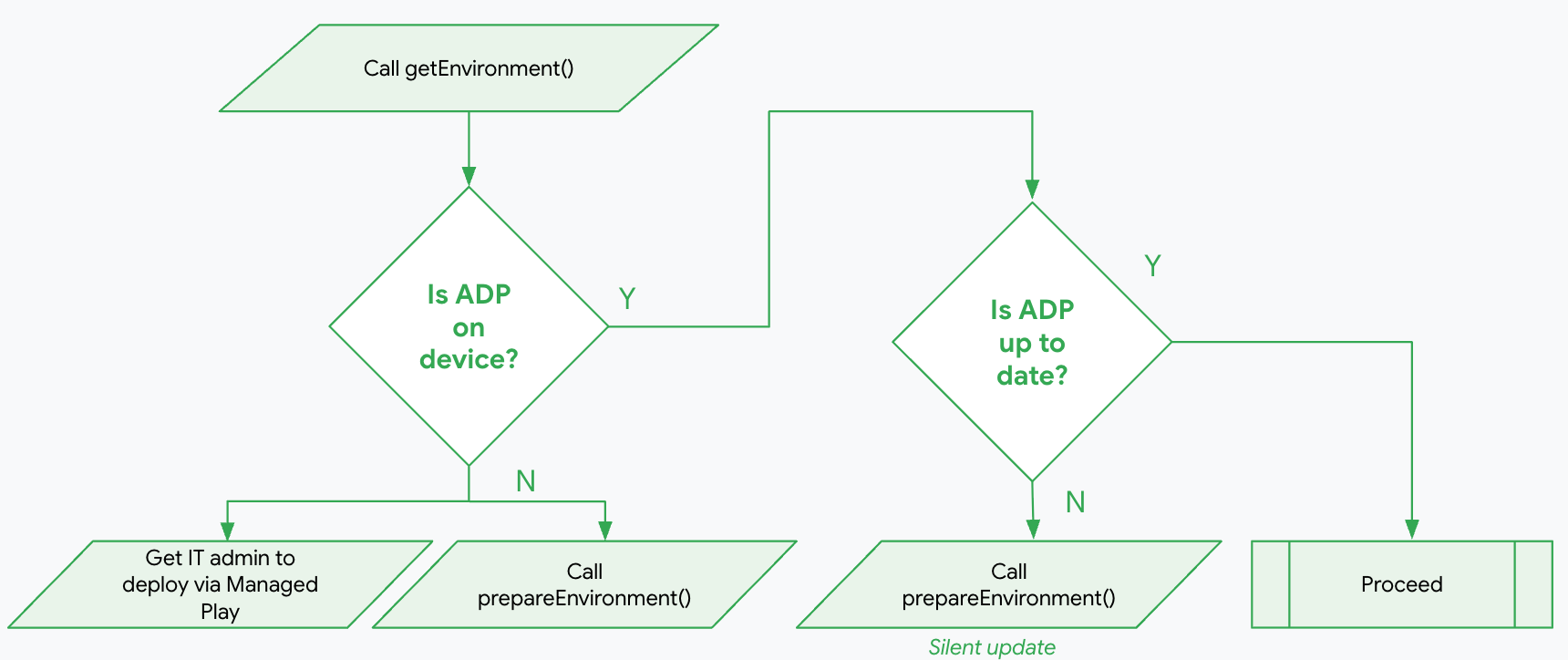本文档应作为您使用 AMAPI SDK 来接收设备信任信号的主要指南。
借助 AMAPI SDK,您的应用(我们有时也称为“配套”应用)可以从 ADP(Android Device Policy)应用访问设备信任信号。然后,您的应用可以使用这些信号来计算设备的信任状态,并根据选择执行业务逻辑。
前提条件
- 对设备信任信号的访问受到限制,以防止未经授权的使用。如需了解如何申请,请前往设备信任信号访问权限页面。
- Android Enterprise 建议您将 Play Integrity API 套件集成到客户端应用中,并在读取和依赖设备信任信号之前参考结果。如果设备未通过 Play Integrity API 检查,则不应信任该设备,也不应信任用于确定信任状态的任何源自该设备的信号。如需了解详情,请参阅 Play Integrity 文档。
在应用中与 AMAPI SDK 集成
如需访问设备信任信号,您的应用必须与 AMAPI SDK 集成。如需详细了解此库以及如何将其添加到应用中,请参阅 AMAPI SDK 集成指南。
添加必需权限
从 Android Enterprise API 的设备信任返回的某些信号要求应用声明最初访问此信息所需的相同权限,具体而言:
| 信号 | 所需权限 |
|---|---|
| 网络状态 | ACCESS_NETWORK_STATE |
| 屏幕锁定复杂度 | REQUEST_PASSWORD_COMPLEXITY |
如果应用的 AndroidManifest.xml 中未包含这些权限,Android Enterprise API 的设备信任度将在相关信号的元数据中返回 PERMISSION_ISSUE:
internalDeviceSettings=DeviceSettings{
screenLockComplexity=COMPLEXITY_UNSPECIFIED,
internalScreenLockComplexityMetadata=Metadata{
dataIssues=[
DataIssue{
issueType=PERMISSION_ISSUE,
issueLevel=WARNING,
issueDetails=IssueDetailsCase{none}
}
]
},
如需了解更多详情,请参阅可用的设备信任信号列表。
访问设备信任信号的步骤
想要访问设备信任信号的应用必须验证客户端环境是否为最新版本,并在必要时更新客户端环境。
访问设备信任信号的步骤如下:

验证客户端环境
以下代码示例展示了如何使用 getEnvironment 读取 ADP 应用的当前状态。如果环境已准备就绪且是最新的,您的应用随后可以创建 deviceClient 来访问设备信任信号(请参阅访问设备信任信号)。
Kotlin
import com.google.android.managementapi.common.model.Role import com.google.android.managementapi.device.DeviceClient import com.google.android.managementapi.device.DeviceClientFactory import com.google.android.managementapi.device.model.GetDeviceRequest import com.google.android.managementapi.environment.EnvironmentClient import com.google.android.managementapi.environment.EnvironmentClientFactory import com.google.android.managementapi.environment.model.Environment.AndroidDevicePolicyEnvironment.State.INSTALLED import com.google.android.managementapi.environment.model.Environment.AndroidDevicePolicyEnvironment.State.NOT_INSTALLED import com.google.android.managementapi.environment.model.Environment.AndroidDevicePolicyEnvironment.State.READY import com.google.android.managementapi.environment.model.Environment.AndroidDevicePolicyEnvironment.Version.UP_TO_DATE import com.google.android.managementapi.environment.model.GetEnvironmentRequest import com.google.android.managementapi.environment.model.PrepareEnvironmentRequest try { val context = applicationContext val roles = listOf(Role.builder().setRoleType(Role.RoleType.IDENTITY_PROVIDER).build()) val request = GetEnvironmentRequest.builder().setRoles(roles).build() val environmentClient = EnvironmentClientFactory.create(context) val environmentResponse = environmentClient.getEnvironment(request) if (environmentResponse.hasAndroidDevicePolicyEnvironment()) { val adpEnvironment = environmentResponse.androidDevicePolicyEnvironment if (adpEnvironment.state == READY && adpEnvironment.version == UP_TO_DATE) { // AMAPI Environment State OK, Version OK. Requesting Device signals.. checkDevice(deviceClient = DeviceClientFactory.create(context)) } else if (adpEnvironment.state == INSTALLED) { // prepareEnvironment should be called, calling // prepareEnvironment won't show the UI prepareEnvironment(context, environmentClient) } else if (adpEnvironment.state == NOT_INSTALLED) { // prepareEnvironment should be called, calling // prepareEnvironment will show the UI prepareEnvironment(context, environmentClient) } } } catch (e: Exception) { Log.e(TAG, "Exception", e) }
Java
import static com.google.android.managementapi.environment.model.Environment.AndroidDevicePolicyEnvironment.State.INSTALLED; import static com.google.android.managementapi.environment.model.Environment.AndroidDevicePolicyEnvironment.State.NOT_INSTALLED; import static com.google.android.managementapi.environment.model.Environment.AndroidDevicePolicyEnvironment.State.READY; import static com.google.android.managementapi.environment.model.Environment.AndroidDevicePolicyEnvironment.Version.UP_TO_DATE; import com.google.android.managementapi.common.model.Role; import com.google.android.managementapi.device.DeviceClient; import com.google.android.managementapi.device.DeviceClientFactory; import com.google.android.managementapi.device.model.Device; import com.google.android.managementapi.device.model.GetDeviceRequest; import com.google.android.managementapi.environment.EnvironmentClient; import com.google.android.managementapi.environment.EnvironmentClientFactory; import com.google.android.managementapi.environment.model.Environment; import com.google.android.managementapi.environment.model.Environment.AndroidDevicePolicyEnvironment; import com.google.android.managementapi.environment.model.GetEnvironmentRequest; import com.google.android.managementapi.environment.model.PrepareEnvironmentRequest; import com.google.android.managementapi.environment.model.PrepareEnvironmentResponse; try { Context context = getApplicationContext(); ImmutableListroles = new ImmutableList.Builder () .add(Role.builder() .setRoleType(Role.RoleType.IDENTITY_PROVIDER) .build()) .build(); EnvironmentClient environmentClient = EnvironmentClientFactory.create(context); GetEnvironmentRequest request = GetEnvironmentRequest.builder() .setRoles(roles) .build(); ListenableFuture getEnvironmentFuture = environmentClient.getEnvironmentAsync(request); Futures.addCallback(getEnvironmentFuture, new FutureCallback<>() { @Override public void onSuccess(Environment environment) { AndroidDevicePolicyEnvironment adpEnvironment = environment.getAndroidDevicePolicyEnvironment(); AndroidDevicePolicyEnvironment.State state = adpEnvironment.getState(); AndroidDevicePolicyEnvironment.Version version = adpEnvironment.getVersion(); if (state == READY && version == UP_TO_DATE) { // AMAPI Environment State OK, Version OK. Requesting Device signals.. DeviceClient deviceClient = DeviceClientFactory.create(context); checkDevice(deviceClient); } else if (state == INSTALLED) { // prepareEnvironment should be called, calling // prepareEnvironment won't show the UI prepareEnvironment(context, environmentClient); } else if (state == NOT_INSTALLED) { // prepareEnvironment should be called, calling // prepareEnvironment will show the UI prepareEnvironment(context, environmentClient); } } @Override public void onFailure(Throwable t) { Log.d(TAG, t.toString()); } }, MoreExecutors.directExecutor()); } catch (Exception e) { Log.d(TAG, e.toString()); }
如果 ADP 应用已安装但不是最新版本,您的应用应调用 prepareEnvironment 以在不发出提示的情况下更新 ADP 应用,而无需用户干预。
如果未安装 ADP 应用,您的应用可以调用 prepareEnvironment 来提示用户安装 ADP 应用。请参阅准备客户端环境。
准备客户端环境
如果 ADP 应用已安装,该 API 将在用户不知情的情况下自动更新该应用。
如果未安装 ADP 应用,该 API 会提示用户接受 ADP 应用的安装。

您可以注册一个回调来监控用户选择。如需了解更多详情,请参阅在 ADP 应用安装期间跟踪用户互动。
我们建议在初始配置用户体验流程期间从前台进程完成 prepareEnvironment 调用,以避免向用户显示令人意外的安装 Android 设备政策 模态对话框。如果无法从前台进程进行调用(因为这是一个 Web 流程,并且 Android 组件没有界面),则允许从后台进行调用,但前提是必须在初始配置用户体验流程期间进行。
正确设置环境后,即可访问设备信任信号。请参阅访问设备信任信号。
Kotlin
try { val myNotificationReceiverService = ComponentName( context, MyNotificationReceiverService::class.java ) val roles = listOf(Role.builder().setRoleType(Role.RoleType.IDENTITY_PROVIDER).build()) val request = PrepareEnvironmentRequest.builder().setRoles(roles).build() val response = environmentClient.prepareEnvironment(request, myNotificationReceiverService) val environment = response.environment val adpEnvironment = environment.androidDevicePolicyEnvironment val state = adpEnvironment.state val version = adpEnvironment.version if (state == READY && version == UP_TO_DATE) { // Environment is prepared, access device posture signals using // DeviceClient. checkDevice(deviceClient = DeviceClientFactory.create(context)) } else { // The prepareEnvironment call failed to prepare Log.w( TAG, "AMAPI environment was not ready: " + state + " - " + version ) } } catch (e: java.lang.Exception) { Log.d(TAG, e.toString()) }
Java
try { ComponentName myNotificationReceiverService = new ComponentName( context, MyNotificationReceiverService.class ); ImmutableListroles = new ImmutableList.Builder () .add(Role.builder() .setRoleType(Role.RoleType.IDENTITY_PROVIDER) .build()) .build(); PrepareEnvironmentRequest request = PrepareEnvironmentRequest.builder() .setRoles(roles) .build(); ListenableFuture environmentFuture = environmentClient.prepareEnvironmentAsync( request, myNotificationReceiverService ); Futures.addCallback(environmentFuture, new FutureCallback<>() { @Override public void onSuccess(PrepareEnvironmentResponse response) { Environment environment = response.getEnvironment(); AndroidDevicePolicyEnvironment adpEnvironment = environment.getAndroidDevicePolicyEnvironment(); AndroidDevicePolicyEnvironment.State state = adpEnvironment.getState(); AndroidDevicePolicyEnvironment.Version version = adpEnvironment.getVersion(); if (state == READY && version == UP_TO_DATE) { // AMAPI Environment State OK, Version OK. Requesting Device signals.. DeviceClient deviceClient = DeviceClientFactory.create(context); checkDevice(deviceClient); } else { // The prepareEnvironment call failed to prepare Log.w( TAG, "AMAPI environment was not ready: " + adpEnvironment.getState() + " - " + adpEnvironment.getVersion() ); } } @Override public void onFailure(@NonNull Throwable t) { // Handle the error Log.d(TAG, "AMAPI response did not contain an ADP environment"); } }, MoreExecutors.directExecutor()); } catch (Exception e) { Log.d(TAG, e.toString()); }
DeviceClient 用法建议
创建 DeviceClient 实例会与 Android 设备政策 (ADP) 应用建立通信渠道。为了优化性能,我们建议使用 DeviceClientFactory.create() 创建单个 DeviceClient 实例,并将其缓存以供整个应用重复使用,例如通过使用依赖项注入。避免在另一个 DeviceClient 实例仍处于活动状态时创建新实例,因为这可能会强制关闭现有通信渠道,不仅会产生开销,还可能导致资源泄露和其他潜在问题。
访问设备信任信号
如需访问您感兴趣的设备信任信号,可以使用上一步中看到的 deviceClient 实例来请求 Device 对象。
Kotlin
try { kotlin.runCatching { deviceClient.getDeviceAwait(GetDeviceRequest.getDefaultInstance()) }.onFailure { t -> Log.d(TAG, t.toString()) }.onSuccess { device -> // Access device posture signals available in device val deviceString = device.toString() Log.d(TAG, deviceString) } } catch (e: java.lang.Exception) { Log.d(TAG, e.toString()) }
Java
try { ListenableFuturedeviceFuture = deviceClient.getDevice(GetDeviceRequest.getDefaultInstance()); Futures.addCallback(deviceFuture, new FutureCallback () { @Override public void onSuccess(Device device) { // Access device posture signals available in device String deviceString = device.toString(); Log.d(TAG, deviceString); } @Override public void onFailure(Throwable t) { Log.d(TAG, Log.d(TAG, t.toString()); } }, MoreExecutors.directExecutor()); } catch (Exception e) { Log.d(TAG, e.toString()); }
处理错误
如果应用发出设备信任请求,但调用失败,则应用会收到异常。出现这些例外情况的原因有很多,例如:
SecurityException- 您的应用未注册以访问设备信任信号。请参阅设备信任信号访问权限。AmapiSdkException的子类 - ADP 不存在或未就绪。这可能是由暂时性情况引起的,您应重试调用。
重试策略
对于因暂时性情况而导致的异常,请实现采用指数退避算法的重试策略。第一次失败后,先延迟 5 秒钟,然后再重试。
实现重试策略,将尝试次数上限作为退出条件,每次都以指数方式增加延迟时间(10 秒、20 秒等)。
跟踪 ADP 应用安装期间的用户互动
如果设备需要在 prepareEnvironment 期间安装 ADP 应用,您的应用可以通过实现 NotificationReceiverService 来跟踪用户互动,以接收覆盖 getPrepareEnvironmentListener 的通知:
Kotlin
import android.util.Log import com.google.android.managementapi.environment.EnvironmentListener import com.google.android.managementapi.environment.model.EnvironmentEvent.EventCase.Kind.ANDROID_DEVICE_POLICY_INSTALL_CONSENT_ACCEPTED import com.google.android.managementapi.environment.model.EnvironmentEvent import com.google.android.managementapi.notification.NotificationReceiverService class MyNotificationReceiverService : NotificationReceiverService() { override fun getPrepareEnvironmentListener(): EnvironmentListener { return MyEnvironmentListener() } } class MyEnvironmentListener : EnvironmentListener { override fun onEnvironmentEvent( event: EnvironmentEvent ) { if (event.event.kind == ANDROID_DEVICE_POLICY_INSTALL_CONSENT_ACCEPTED) { Log.d(TAG, "User provided install consent") } else { Log.d(TAG, "User rejected install consent") } } companion object { private val TAG: String = MyEnvironmentListener::class.java.simpleName } }
Java
import static com.google.android.managementapi.environment.model.EnvironmentEvent.EventCase.Kind.ANDROID_DEVICE_POLICY_INSTALL_CONSENT_ACCEPTED; import android.util.Log; import androidx.annotation.NonNull; import com.google.android.managementapi.environment.EnvironmentListener; import com.google.android.managementapi.environment.model.EnvironmentEvent; import com.google.android.managementapi.notification.NotificationReceiverService; class MyNotificationReceiverService extends NotificationReceiverService { @NonNull @Override protected EnvironmentListener getPrepareEnvironmentListener() { return new MyEnvironmentListener(); } } class MyEnvironmentListener implements EnvironmentListener { final private String TAG = MyEnvironmentListener.class.getSimpleName(); @Override public void onEnvironmentEvent(EnvironmentEvent event) { if (event.getEvent().getKind() == ANDROID_DEVICE_POLICY_INSTALL_CONSENT_ACCEPTED) { Log.d(TAG, "User provided install consent"); } else { Log.d(TAG, "User rejected install consent"); } } }
已知问题
目前没有已知问题。

